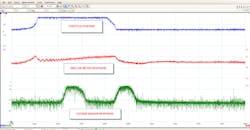How to use an oscilloscope to diagnose a stalling vehicle
Steve Smith, automotive application specialist at Pico Technology, offers an overview of how an oscilloscope helps diagnose a stalling vehicle. He also explains why an oscilloscope is an important tool in this procedure.
Q: How will the oscilloscopes be used to diagnose a stalling vehicle?
A: From the outset, engine stalling (like all diagnostic procedures) needs to be evaluated by an interview with your customer as they have all the answers and more importantly the history/sequence of events
A basic inspection must never be overlooked before any diagnosis as it is all too easy to attack vehicles with an array of test equipment when in fact our concern could be contaminated fuel!
Confirmation of the customers concern is paramount and ideally with a scan tool attached to gather valuable data during the fault condition. This is not always possible as faults are often intermittent and dependent on driving conditions and so again, the customer interview will assist
Diagnostic trouble codes are always the first port of call along with any serial data from your chosen Scan tool. Road testing the vehicle with your scan tool connected whilst trying to simulate the condition will also assist to provide target areas for further diagnosis and testing and this is where oscilloscope becomes invaluable.
Armed with all the information above the technician will be required to follow a fault code flowchart if a relevant fault code is present, or, armed with his knowledge of the system will begin to test and measure components of the engine management with an oscilloscope that could be responsible for the customers symptom.
To give a typical example, let’s take a gas engine stalling when stopping at junctions but no fault codes evident. A description of the engine idle control system is required and a list complied of possible components that could produce the staling. From this list the technician may decide to test the, oxygen sensor, airflow meter, and throttle position sensor. The order of tests depends on the ease of access to these components but with a Pico 4 channel scope all these inputs can be measured and monitored in real time on one screen.
Using the Picoscope gives the technician the advantage to monitor (in real time) the actual live signals and compare them to the processed data from the scan tool.
Q: Why use an oscilloscope not just a scan tool?
A: Once connected to the components the technician is able to look at the cause and effect of various sensors on the idle control system. A wiggle test is such a simple yet effective technique when looking at signals that may be interrupted due to wiring failures, connection issues, and heat damage. Only the oscilloscope can respond fast enough to display these “glitches” where the scan tool would miss this vital “drop out” in signal integrity so leading the technician on a potential goose chase. The oscilloscope can also be used during road tests when most faults occur, allowing the technician the same high speed capture ability under the operating conditions reported by the customer. The oscilloscope can record the signals above and when the fault occurs the technician is able to pause and playback the captured data, zoom, measure, and evaluate the signals to conclude a diagnosis as to why the vehicle may have stalled
Q: What can I expect from a technician using an oscilloscope?
A: From experience, oscilloscope users are dedicated professionals who have invested both time and money (often their own) to improve their diagnostic capability in the ever increasing complexity of today’s vehicles. You can expect your vehicle repaired in a realistic time backed with proof of component failure with supporting literature of before and after fix that will deliver confidence in any repair.
Q: Where can I see a Picoscope in action?
A: Our website, “www.picoauto.com” holds a wealth of information and a fountain of knowledge when looking to purchase not just a Picoscope but the numerous accessories that complement our scopes and increase your test and measurement capability. Real life case studies and tutorials are also available along with links to Pico TV where you will find countless video tutorials on measurement techniques using our scope. Picoscope is an oscilloscope used by professionals all over the world in various professions who know they can trust both the product and customer support that comes with all our products.
